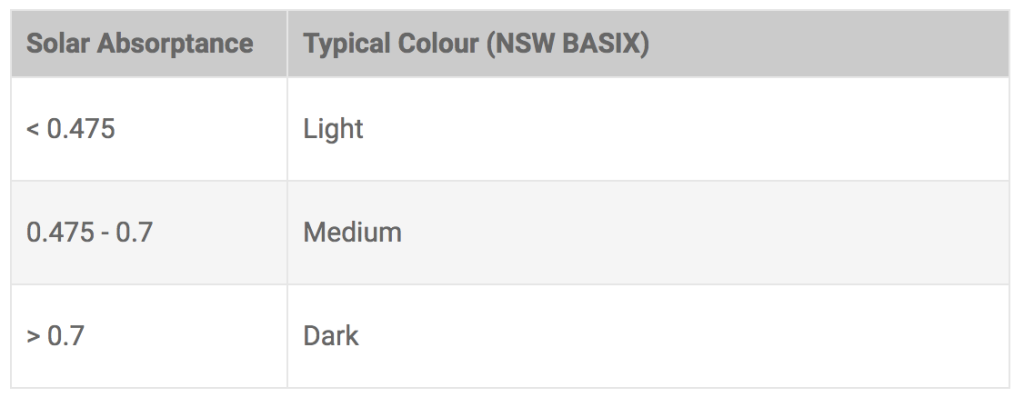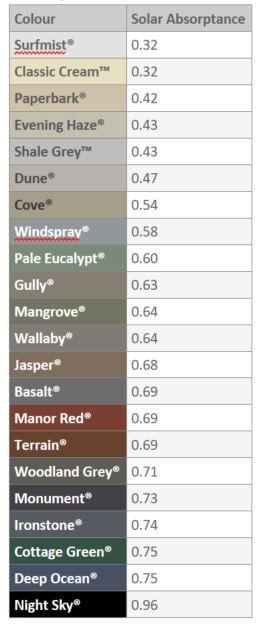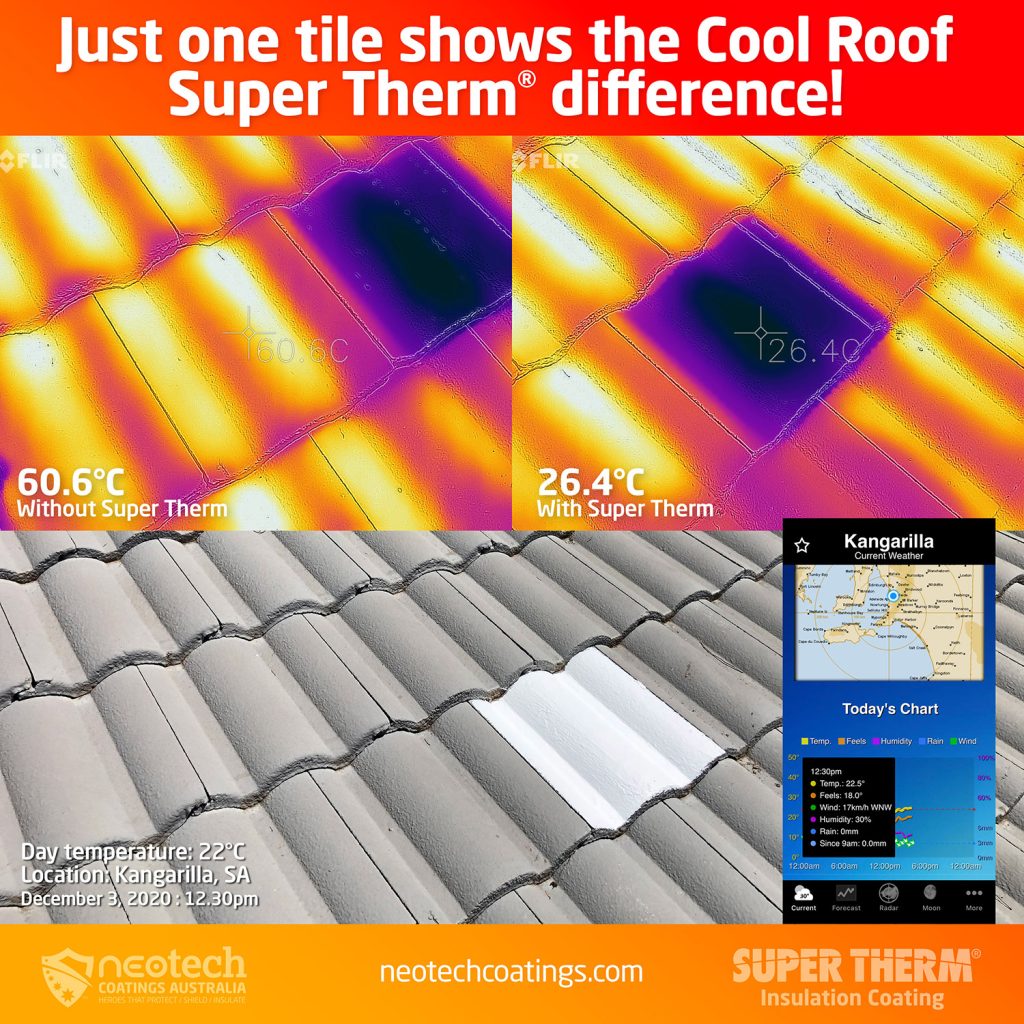Does roof colour really make a difference?
The physics are indisputable, light, reflective surfaces absorb less heat and can have a dramatic impact in cooling the surrounding air. Dark colours absorb the heat therefore heat up the surrounding atmosphere. So why are there strange beliefs that cool roof colours don’t make a difference to solar heat absorption or energy efficiency into a building or home. Scientific knowledge that colours make a difference to energy efficiency is reported worldwide by some highly respected universities, organisations and institutions yet still denied by some:
- Pro-bulk insulation fans
- Traditional sustainability advocates
- Self interested groups
- Building materials companies
- Some government entities
Here’s the arguments against cool roofs:
- All paints and coatings are the same and don’t work anyway
- Having an air tight building with bulk insulation is all you need
- Allowing lower standards of what’s acceptable with solar absorption
- Winter is more important than summer due to heating
- Only absorbing a third of the heat is pretty good
- Building codes don’t think its too important
- Zinc and galvanised roofs are more reflective
- What about your poor neighbours when the sun shines on the roof?
- Heat island effect is only significant when there is no wind
- Natural colours are better like green and terracotta
- Shiny metal like a mirror and better
- Some estates and councils won’t allow it either
- Solar Reflectance Index (SRI) is all you need to know
- Cool roofs can’t save lives
Let’s compare the basic sock test. The white sock is about 33°C and the black sock close to 46°C. Even the simplest test shows colour relates to heat absorption.
Solar Absorptance
On hot sunny days, light coloured (low solar absorptance) roofing material commonly keeps cooler than darker coloured (high solar absorptance) roofing material. To recognise the cooling benefit of lower solar absorptance roofing, some building regulations have incorporated it as an energy efficiency design parameter.

The classification of colours in national and state regulation is based on solar absorptance (SA). SA is the proportion of the total incident solar radiation that is absorbed by the roofing material (the remainder is reflected) and is expressed as a ratio between 0 and 1. A roof with a lower solar absorptance will absorb less heat than a roof with a higher solar absorptance and may help keep the roof space and building cooler on a hot day…Results will depend on roof colour, level and location of insulation, type and location of building shape and function (source).
Does roof colour really make a difference?
https://www.lighthouseteam.com.au/journal/does-roof-colour-really-make-a-difference?
In a well-designed, and properly insulated home (where there are very few ceiling penetrations or insulation gaps and little opportunity for air leakage) in Canberra, roof colour makes very little difference – in winter or summer. We do light, medium and high solar absorptance roofs. Jenny’s own roof is Colorbond ‘Deep Ocean’ which is classed as dark with a high solar absorptance of 0.75.
In Canberra’s cool temperate climate (climate zone 7 of the NCC, climate zone 24 in NatHERS) which, despite climate change, is still heavily dominated by heating requirements, it is actually ever so slightly beneficial at the house level to have a darker roof. Another thing that people don’t think about is that lighter roofs actually get colder in the depths of winter making condensation underneath them more likely.
Jenny worries that people think changing roof colour is going to have a dramatic impact in our suburbs. Only smaller homes and more gardens will do that. People in McMansions, with little landscaping and greenery, should not feel virtuous for having a light coloured roof. They also should not expect their home to feel way more comfortable… if it does, then we strongly suspect the ceiling is not properly insulated or draught sealed.
Of course, in warmer climates (which don’t get winter extremes like Canberra), where energy for cooling is the major issue, then a lighter coloured roof will be more worthwhile. Speak to an energy assessor in your area to see what is most suitable in your climate.
Colorbond

21 out of the 22 colours in the COLORBOND® steel Classic and Contemporary colour range incorporate our unique Thermatech® solar reflectance technology, designed to reflect more of the sun’s heat on hot sunny days by optimising solar reflectance properties. It’s widely known that lighter colours are better at reflecting heat. With Thermatech® solar reflectance technology, even the darker colours in the COLORBOND® steel range have solar reflective properties which may help your building stay cooler. Thermatech® technology is designed to reflect more of the sun’s heat on hot sunny days, which can mean less dependence on air-conditioning1.
According to https://www.watermasterroofing.com.au/does-colour-matter-choosing-new-metal-roof/
COLORBOND metal roofing comes with reflective coatings that serve to reduce the amount of heat that’s absorbed by your metal roof, thereby increasing your home’s thermal efficiency.
This reduces your reliance on air conditioning, making your home more energy-efficient to boot.
Cool roofs versus dark roofs: special report
It started with an article on a study out of Berkeley Lab in California, which concluded that white roofs outperformed black roofs economically as well as environmentally. It called for the phasing out of dark roofs in hot climates, especially those prone to heatwaves. This would reduce energy costs, protect against the urban heat island effect and tackle climate change.
“Research shows that light coloured roof tiles can lower the air temperature in the roof space by up to nine degrees compared to dark tiles.”
It also noted that “research shows that light coloured roof tiles can lower the air temperature in the roof space by up to nine degrees compared to dark tiles”.
How to Make Your Roof Tiles Energy Efficient
Colour of roofing should be considered again in relation to thermal performance. Most of Australia has a climate which requires the roof to limit heat gain rather than heat loss. The colour of an exposed surface determines the amount of solar radiation which will be absorbed. The uninsulated concrete tiles have a low thermal resistance (R1.3) and a thermal lag of less than one hour. Nevertheless this offers a slight thermal advantage over thin, highly conductive metal roofing materials (source).
Roof tiles have a relatively high thermal mass, meaning that there is a dampening effect as the heat has to travel through the material, whereas thin metal sheets transfer heat directly between external and internal surfaces (source).
However, research the RTAA commissioned, performed by the University of Newcastle, found that light coloured tiles yielded “energy savings between 25-36 per cent compared to dark coloured tiles”. Super Therm® is able to block the solar heat and keep tiles cool, therefore reduce the heat gain into your home.













